Oxford College 5UEFM Level 5 Financial Management Open-book Exam
VerifiedAdded on 2020/10/26
|22
|5908
|1273
Homework Assignment
AI Summary
This document presents a student's response to a Level 5 open-book exam on Effective Financial Management (5UEFM), focusing on the financial strategies and performance of The Coca-Cola Company. The exam addresses key aspects of financial management, including its objectives and the roles of different stakeholders like customers, employees, and shareholders. The student analyzes Coca-Cola's financial planning, budgeting, market effectiveness, and its ability to navigate challenges like foreign currency fluctuations and competition. Furthermore, the assignment recommends how projected financial statements and other measures of business performance can be used by Coca-Cola to evaluate its activities and processes. The analysis includes a review of the balance sheet, cash flow analysis, and expenditure forecasts to assess the company's financial health and growth potential. The student emphasizes the importance of financial management in achieving business success and the company's effective capital management plans.
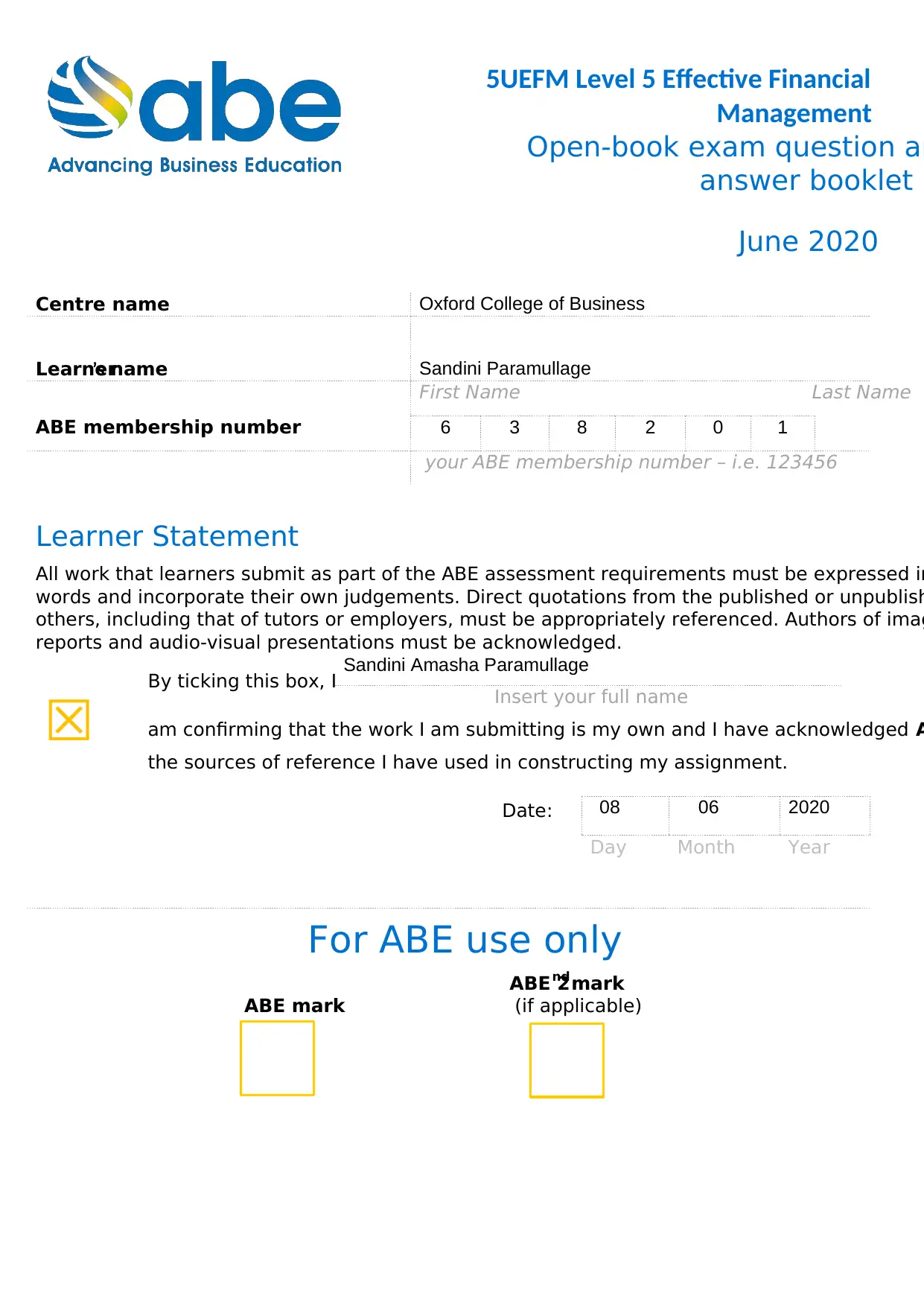
June 2020
Centre name Oxford College of Business
Learner’s name Sandini Paramullage
First Name Last Name
ABE membership number 6 3 8 2 0 1
your ABE membership number – i.e. 123456
Learner Statement
All work that learners submit as part of the ABE assessment requirements must be expressed in
words and incorporate their own judgements. Direct quotations from the published or unpublish
others, including that of tutors or employers, must be appropriately referenced. Authors of imag
reports and audio-visual presentations must be acknowledged.
☒ By ticking this box, I Sandini Amasha Paramullage
Insert your full name
am confirming that the work I am submitting is my own and I have acknowledged A
the sources of reference I have used in constructing my assignment.
Date: 08 06 2020
Day Month Year
For ABE use only
ABE 2nd mark
ABE mark (if applicable)
5UEFM Level 5 Effective Financial
Management
Open-book exam question an
answer booklet
Centre name Oxford College of Business
Learner’s name Sandini Paramullage
First Name Last Name
ABE membership number 6 3 8 2 0 1
your ABE membership number – i.e. 123456
Learner Statement
All work that learners submit as part of the ABE assessment requirements must be expressed in
words and incorporate their own judgements. Direct quotations from the published or unpublish
others, including that of tutors or employers, must be appropriately referenced. Authors of imag
reports and audio-visual presentations must be acknowledged.
☒ By ticking this box, I Sandini Amasha Paramullage
Insert your full name
am confirming that the work I am submitting is my own and I have acknowledged A
the sources of reference I have used in constructing my assignment.
Date: 08 06 2020
Day Month Year
For ABE use only
ABE 2nd mark
ABE mark (if applicable)
5UEFM Level 5 Effective Financial
Management
Open-book exam question an
answer booklet
Paraphrase This Document
Need a fresh take? Get an instant paraphrase of this document with our AI Paraphraser
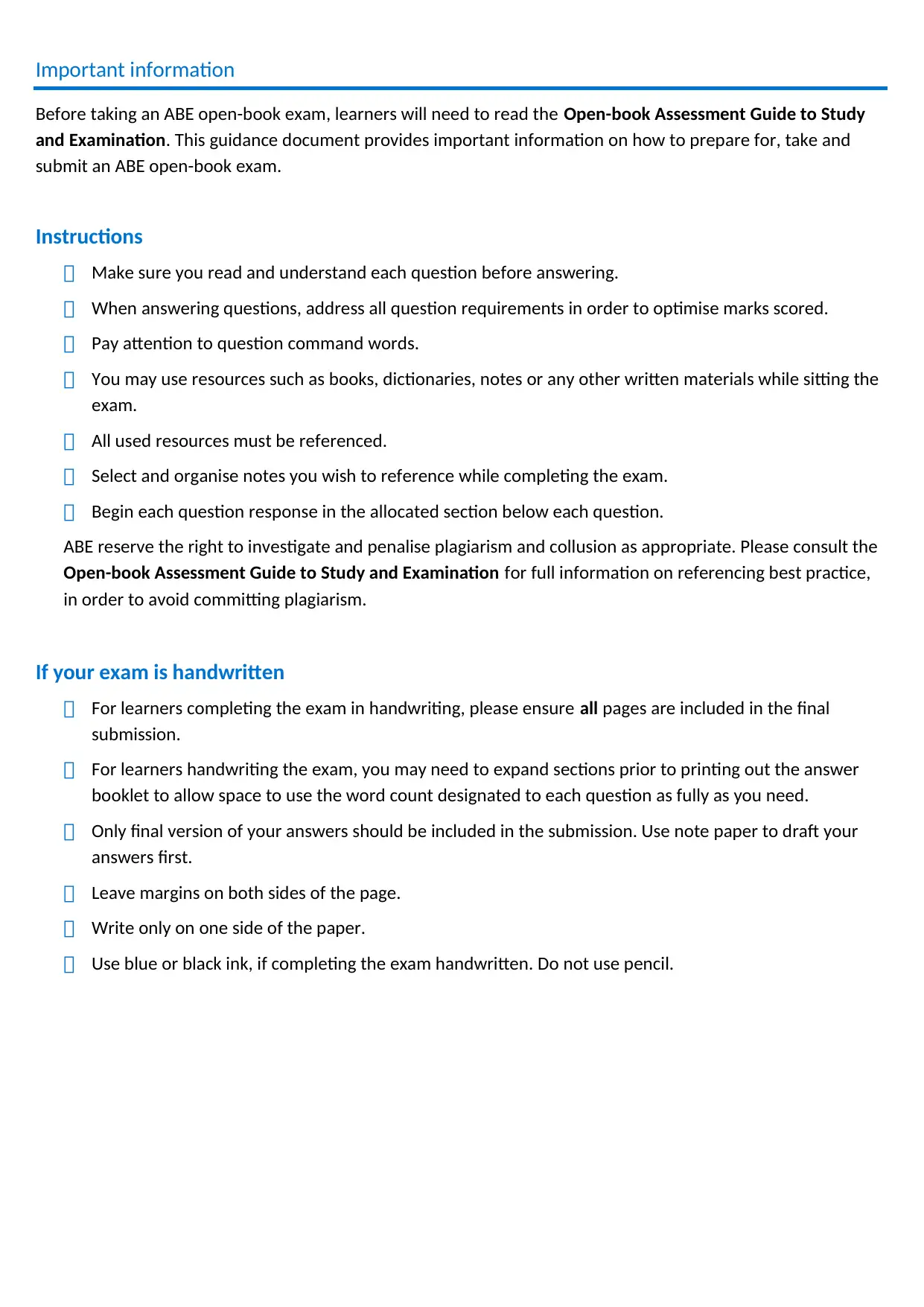
Important information
Before taking an ABE open-book exam, learners will need to read the Open-book Assessment Guide to Study
and Examination. This guidance document provides important information on how to prepare for, take and
submit an ABE open-book exam.
Instructions
Make sure you read and understand each question before answering.
When answering questions, address all question requirements in order to optimise marks scored.
Pay attention to question command words.
You may use resources such as books, dictionaries, notes or any other written materials while sitting the
exam.
All used resources must be referenced.
Select and organise notes you wish to reference while completing the exam.
Begin each question response in the allocated section below each question.
ABE reserve the right to investigate and penalise plagiarism and collusion as appropriate. Please consult the
Open-book Assessment Guide to Study and Examination for full information on referencing best practice,
in order to avoid committing plagiarism.
If your exam is handwritten
For learners completing the exam in handwriting, please ensure all pages are included in the final
submission.
For learners handwriting the exam, you may need to expand sections prior to printing out the answer
booklet to allow space to use the word count designated to each question as fully as you need.
Only final version of your answers should be included in the submission. Use note paper to draft your
answers first.
Leave margins on both sides of the page.
Write only on one side of the paper.
Use blue or black ink, if completing the exam handwritten. Do not use pencil.
Before taking an ABE open-book exam, learners will need to read the Open-book Assessment Guide to Study
and Examination. This guidance document provides important information on how to prepare for, take and
submit an ABE open-book exam.
Instructions
Make sure you read and understand each question before answering.
When answering questions, address all question requirements in order to optimise marks scored.
Pay attention to question command words.
You may use resources such as books, dictionaries, notes or any other written materials while sitting the
exam.
All used resources must be referenced.
Select and organise notes you wish to reference while completing the exam.
Begin each question response in the allocated section below each question.
ABE reserve the right to investigate and penalise plagiarism and collusion as appropriate. Please consult the
Open-book Assessment Guide to Study and Examination for full information on referencing best practice,
in order to avoid committing plagiarism.
If your exam is handwritten
For learners completing the exam in handwriting, please ensure all pages are included in the final
submission.
For learners handwriting the exam, you may need to expand sections prior to printing out the answer
booklet to allow space to use the word count designated to each question as fully as you need.
Only final version of your answers should be included in the submission. Use note paper to draft your
answers first.
Leave margins on both sides of the page.
Write only on one side of the paper.
Use blue or black ink, if completing the exam handwritten. Do not use pencil.
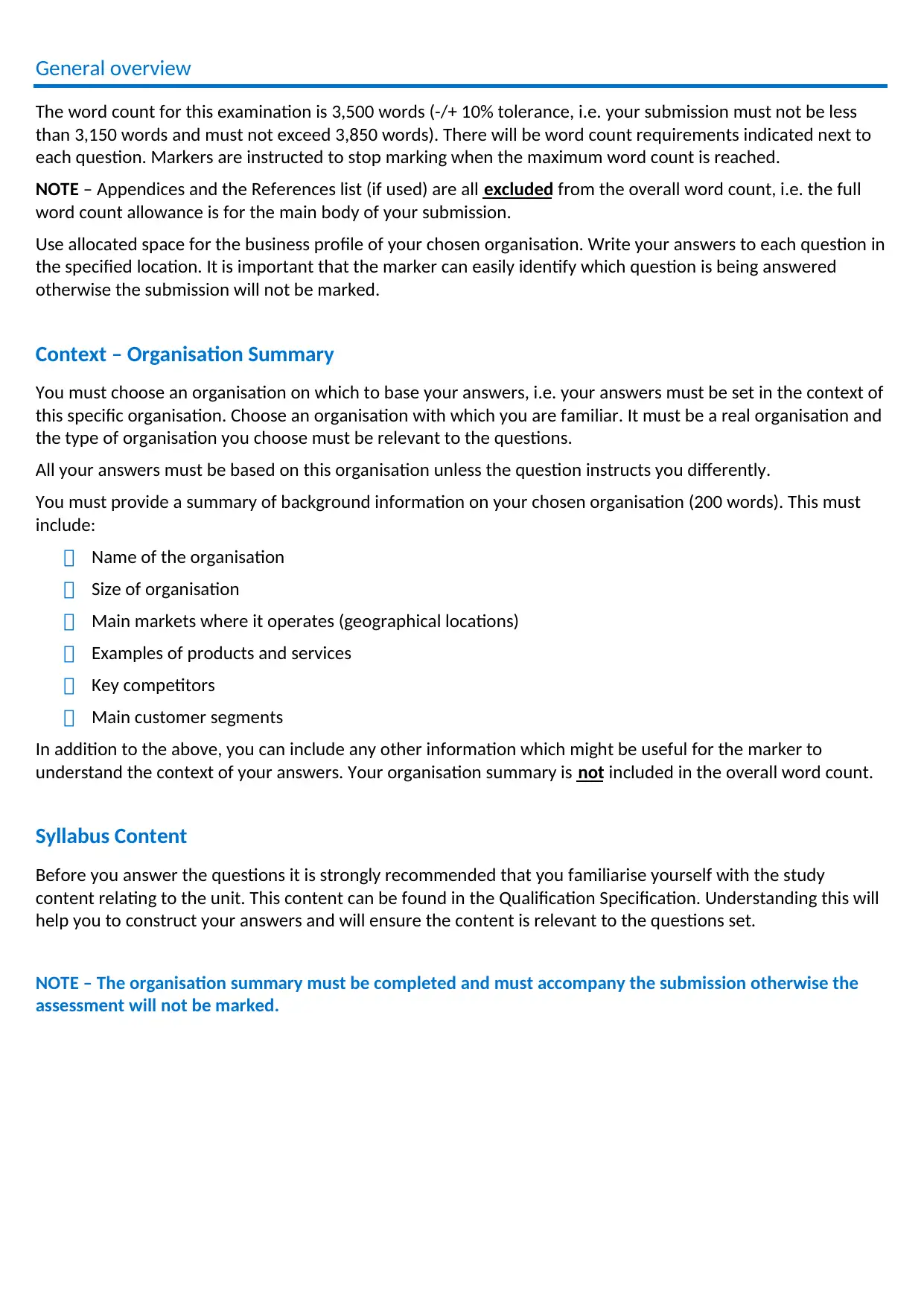
General overview
The word count for this examination is 3,500 words (-/+ 10% tolerance, i.e. your submission must not be less
than 3,150 words and must not exceed 3,850 words). There will be word count requirements indicated next to
each question. Markers are instructed to stop marking when the maximum word count is reached.
NOTE – Appendices and the References list (if used) are all excluded from the overall word count, i.e. the full
word count allowance is for the main body of your submission.
Use allocated space for the business profile of your chosen organisation. Write your answers to each question in
the specified location. It is important that the marker can easily identify which question is being answered
otherwise the submission will not be marked.
Context – Organisation Summary
You must choose an organisation on which to base your answers, i.e. your answers must be set in the context of
this specific organisation. Choose an organisation with which you are familiar. It must be a real organisation and
the type of organisation you choose must be relevant to the questions.
All your answers must be based on this organisation unless the question instructs you differently.
You must provide a summary of background information on your chosen organisation (200 words). This must
include:
Name of the organisation
Size of organisation
Main markets where it operates (geographical locations)
Examples of products and services
Key competitors
Main customer segments
In addition to the above, you can include any other information which might be useful for the marker to
understand the context of your answers. Your organisation summary is not included in the overall word count.
Syllabus Content
Before you answer the questions it is strongly recommended that you familiarise yourself with the study
content relating to the unit. This content can be found in the Qualification Specification. Understanding this will
help you to construct your answers and will ensure the content is relevant to the questions set.
NOTE – The organisation summary must be completed and must accompany the submission otherwise the
assessment will not be marked.
The word count for this examination is 3,500 words (-/+ 10% tolerance, i.e. your submission must not be less
than 3,150 words and must not exceed 3,850 words). There will be word count requirements indicated next to
each question. Markers are instructed to stop marking when the maximum word count is reached.
NOTE – Appendices and the References list (if used) are all excluded from the overall word count, i.e. the full
word count allowance is for the main body of your submission.
Use allocated space for the business profile of your chosen organisation. Write your answers to each question in
the specified location. It is important that the marker can easily identify which question is being answered
otherwise the submission will not be marked.
Context – Organisation Summary
You must choose an organisation on which to base your answers, i.e. your answers must be set in the context of
this specific organisation. Choose an organisation with which you are familiar. It must be a real organisation and
the type of organisation you choose must be relevant to the questions.
All your answers must be based on this organisation unless the question instructs you differently.
You must provide a summary of background information on your chosen organisation (200 words). This must
include:
Name of the organisation
Size of organisation
Main markets where it operates (geographical locations)
Examples of products and services
Key competitors
Main customer segments
In addition to the above, you can include any other information which might be useful for the marker to
understand the context of your answers. Your organisation summary is not included in the overall word count.
Syllabus Content
Before you answer the questions it is strongly recommended that you familiarise yourself with the study
content relating to the unit. This content can be found in the Qualification Specification. Understanding this will
help you to construct your answers and will ensure the content is relevant to the questions set.
NOTE – The organisation summary must be completed and must accompany the submission otherwise the
assessment will not be marked.
⊘ This is a preview!⊘
Do you want full access?
Subscribe today to unlock all pages.

Trusted by 1+ million students worldwide
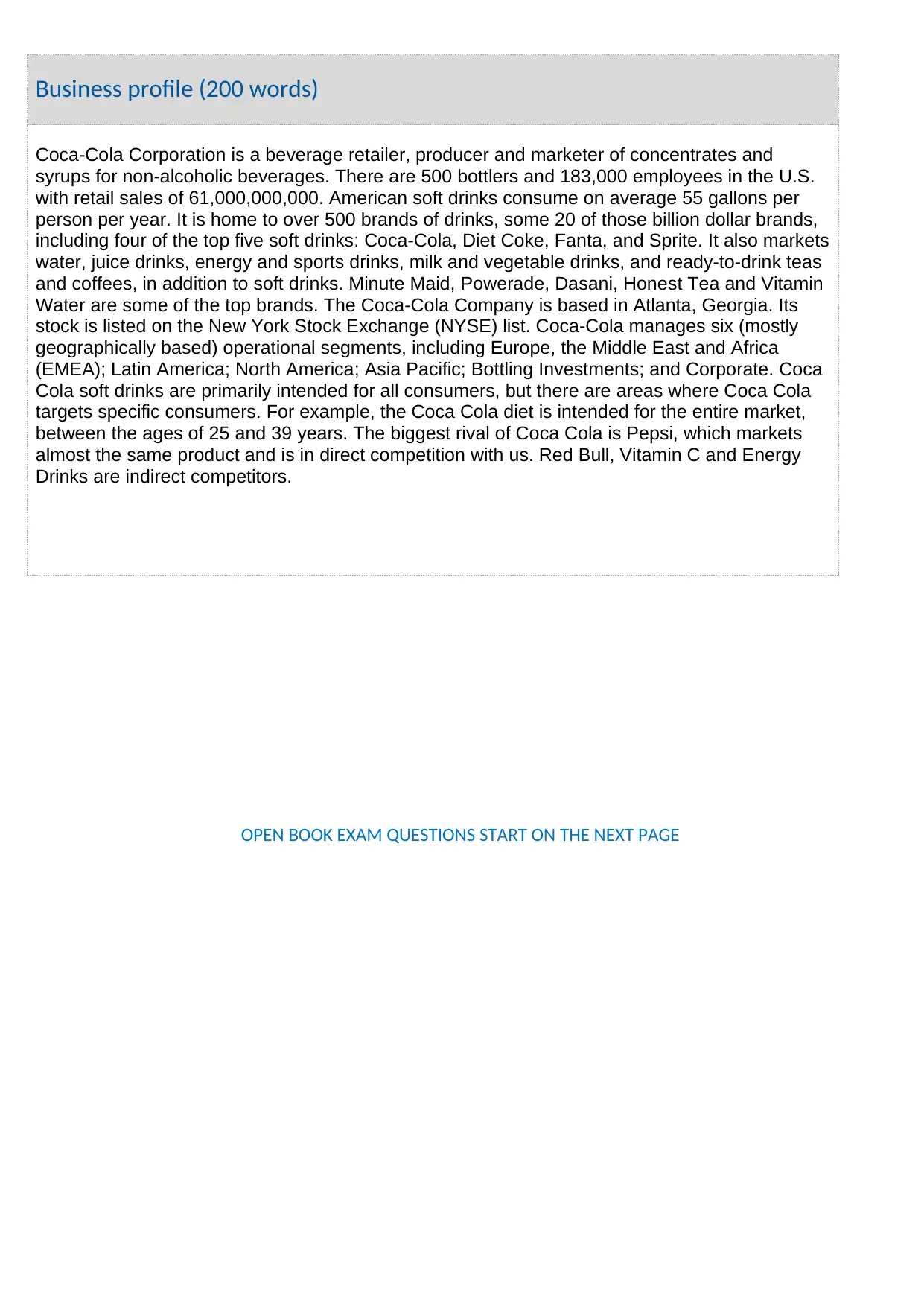
Business profile (200 words)
Coca-Cola Corporation is a beverage retailer, producer and marketer of concentrates and
syrups for non-alcoholic beverages. There are 500 bottlers and 183,000 employees in the U.S.
with retail sales of 61,000,000,000. American soft drinks consume on average 55 gallons per
person per year. It is home to over 500 brands of drinks, some 20 of those billion dollar brands,
including four of the top five soft drinks: Coca-Cola, Diet Coke, Fanta, and Sprite. It also markets
water, juice drinks, energy and sports drinks, milk and vegetable drinks, and ready-to-drink teas
and coffees, in addition to soft drinks. Minute Maid, Powerade, Dasani, Honest Tea and Vitamin
Water are some of the top brands. The Coca-Cola Company is based in Atlanta, Georgia. Its
stock is listed on the New York Stock Exchange (NYSE) list. Coca-Cola manages six (mostly
geographically based) operational segments, including Europe, the Middle East and Africa
(EMEA); Latin America; North America; Asia Pacific; Bottling Investments; and Corporate. Coca
Cola soft drinks are primarily intended for all consumers, but there are areas where Coca Cola
targets specific consumers. For example, the Coca Cola diet is intended for the entire market,
between the ages of 25 and 39 years. The biggest rival of Coca Cola is Pepsi, which markets
almost the same product and is in direct competition with us. Red Bull, Vitamin C and Energy
Drinks are indirect competitors.
OPEN BOOK EXAM QUESTIONS START ON THE NEXT PAGE
Coca-Cola Corporation is a beverage retailer, producer and marketer of concentrates and
syrups for non-alcoholic beverages. There are 500 bottlers and 183,000 employees in the U.S.
with retail sales of 61,000,000,000. American soft drinks consume on average 55 gallons per
person per year. It is home to over 500 brands of drinks, some 20 of those billion dollar brands,
including four of the top five soft drinks: Coca-Cola, Diet Coke, Fanta, and Sprite. It also markets
water, juice drinks, energy and sports drinks, milk and vegetable drinks, and ready-to-drink teas
and coffees, in addition to soft drinks. Minute Maid, Powerade, Dasani, Honest Tea and Vitamin
Water are some of the top brands. The Coca-Cola Company is based in Atlanta, Georgia. Its
stock is listed on the New York Stock Exchange (NYSE) list. Coca-Cola manages six (mostly
geographically based) operational segments, including Europe, the Middle East and Africa
(EMEA); Latin America; North America; Asia Pacific; Bottling Investments; and Corporate. Coca
Cola soft drinks are primarily intended for all consumers, but there are areas where Coca Cola
targets specific consumers. For example, the Coca Cola diet is intended for the entire market,
between the ages of 25 and 39 years. The biggest rival of Coca Cola is Pepsi, which markets
almost the same product and is in direct competition with us. Red Bull, Vitamin C and Energy
Drinks are indirect competitors.
OPEN BOOK EXAM QUESTIONS START ON THE NEXT PAGE
Paraphrase This Document
Need a fresh take? Get an instant paraphrase of this document with our AI Paraphraser
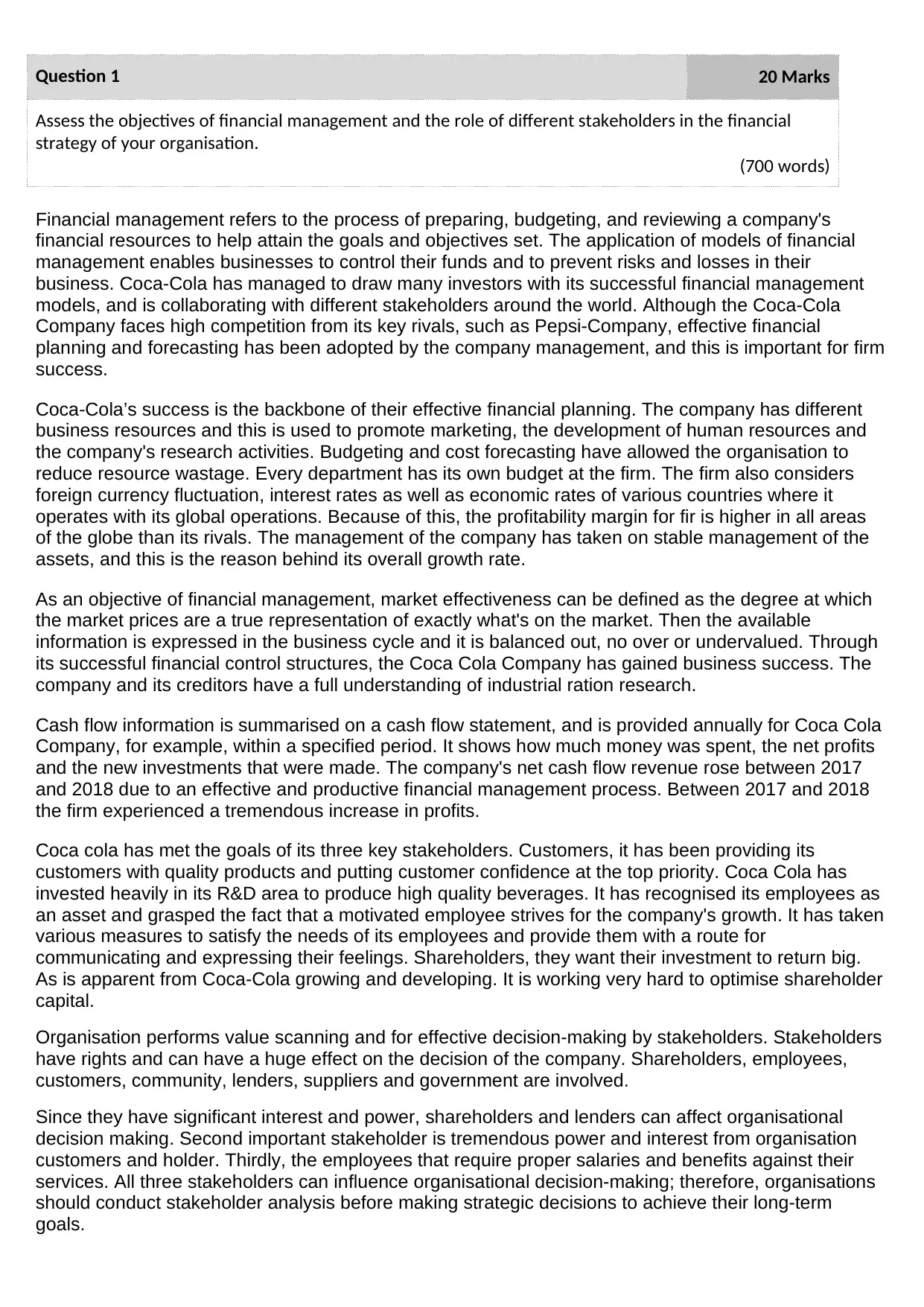
Question 1 20 Marks
Assess the objectives of financial management and the role of different stakeholders in the financial
strategy of your organisation.
(700 words)
Financial management refers to the process of preparing, budgeting, and reviewing a company's
financial resources to help attain the goals and objectives set. The application of models of financial
management enables businesses to control their funds and to prevent risks and losses in their
business. Coca-Cola has managed to draw many investors with its successful financial management
models, and is collaborating with different stakeholders around the world. Although the Coca-Cola
Company faces high competition from its key rivals, such as Pepsi-Company, effective financial
planning and forecasting has been adopted by the company management, and this is important for firm
success.
Coca-Cola’s success is the backbone of their effective financial planning. The company has different
business resources and this is used to promote marketing, the development of human resources and
the company's research activities. Budgeting and cost forecasting have allowed the organisation to
reduce resource wastage. Every department has its own budget at the firm. The firm also considers
foreign currency fluctuation, interest rates as well as economic rates of various countries where it
operates with its global operations. Because of this, the profitability margin for fir is higher in all areas
of the globe than its rivals. The management of the company has taken on stable management of the
assets, and this is the reason behind its overall growth rate.
As an objective of financial management, market effectiveness can be defined as the degree at which
the market prices are a true representation of exactly what's on the market. Then the available
information is expressed in the business cycle and it is balanced out, no over or undervalued. Through
its successful financial control structures, the Coca Cola Company has gained business success. The
company and its creditors have a full understanding of industrial ration research.
Cash flow information is summarised on a cash flow statement, and is provided annually for Coca Cola
Company, for example, within a specified period. It shows how much money was spent, the net profits
and the new investments that were made. The company's net cash flow revenue rose between 2017
and 2018 due to an effective and productive financial management process. Between 2017 and 2018
the firm experienced a tremendous increase in profits.
Coca cola has met the goals of its three key stakeholders. Customers, it has been providing its
customers with quality products and putting customer confidence at the top priority. Coca Cola has
invested heavily in its R&D area to produce high quality beverages. It has recognised its employees as
an asset and grasped the fact that a motivated employee strives for the company's growth. It has taken
various measures to satisfy the needs of its employees and provide them with a route for
communicating and expressing their feelings. Shareholders, they want their investment to return big.
As is apparent from Coca-Cola growing and developing. It is working very hard to optimise shareholder
capital.
Organisation performs value scanning and for effective decision-making by stakeholders. Stakeholders
have rights and can have a huge effect on the decision of the company. Shareholders, employees,
customers, community, lenders, suppliers and government are involved.
Since they have significant interest and power, shareholders and lenders can affect organisational
decision making. Second important stakeholder is tremendous power and interest from organisation
customers and holder. Thirdly, the employees that require proper salaries and benefits against their
services. All three stakeholders can influence organisational decision-making; therefore, organisations
should conduct stakeholder analysis before making strategic decisions to achieve their long-term
goals.
Assess the objectives of financial management and the role of different stakeholders in the financial
strategy of your organisation.
(700 words)
Financial management refers to the process of preparing, budgeting, and reviewing a company's
financial resources to help attain the goals and objectives set. The application of models of financial
management enables businesses to control their funds and to prevent risks and losses in their
business. Coca-Cola has managed to draw many investors with its successful financial management
models, and is collaborating with different stakeholders around the world. Although the Coca-Cola
Company faces high competition from its key rivals, such as Pepsi-Company, effective financial
planning and forecasting has been adopted by the company management, and this is important for firm
success.
Coca-Cola’s success is the backbone of their effective financial planning. The company has different
business resources and this is used to promote marketing, the development of human resources and
the company's research activities. Budgeting and cost forecasting have allowed the organisation to
reduce resource wastage. Every department has its own budget at the firm. The firm also considers
foreign currency fluctuation, interest rates as well as economic rates of various countries where it
operates with its global operations. Because of this, the profitability margin for fir is higher in all areas
of the globe than its rivals. The management of the company has taken on stable management of the
assets, and this is the reason behind its overall growth rate.
As an objective of financial management, market effectiveness can be defined as the degree at which
the market prices are a true representation of exactly what's on the market. Then the available
information is expressed in the business cycle and it is balanced out, no over or undervalued. Through
its successful financial control structures, the Coca Cola Company has gained business success. The
company and its creditors have a full understanding of industrial ration research.
Cash flow information is summarised on a cash flow statement, and is provided annually for Coca Cola
Company, for example, within a specified period. It shows how much money was spent, the net profits
and the new investments that were made. The company's net cash flow revenue rose between 2017
and 2018 due to an effective and productive financial management process. Between 2017 and 2018
the firm experienced a tremendous increase in profits.
Coca cola has met the goals of its three key stakeholders. Customers, it has been providing its
customers with quality products and putting customer confidence at the top priority. Coca Cola has
invested heavily in its R&D area to produce high quality beverages. It has recognised its employees as
an asset and grasped the fact that a motivated employee strives for the company's growth. It has taken
various measures to satisfy the needs of its employees and provide them with a route for
communicating and expressing their feelings. Shareholders, they want their investment to return big.
As is apparent from Coca-Cola growing and developing. It is working very hard to optimise shareholder
capital.
Organisation performs value scanning and for effective decision-making by stakeholders. Stakeholders
have rights and can have a huge effect on the decision of the company. Shareholders, employees,
customers, community, lenders, suppliers and government are involved.
Since they have significant interest and power, shareholders and lenders can affect organisational
decision making. Second important stakeholder is tremendous power and interest from organisation
customers and holder. Thirdly, the employees that require proper salaries and benefits against their
services. All three stakeholders can influence organisational decision-making; therefore, organisations
should conduct stakeholder analysis before making strategic decisions to achieve their long-term
goals.
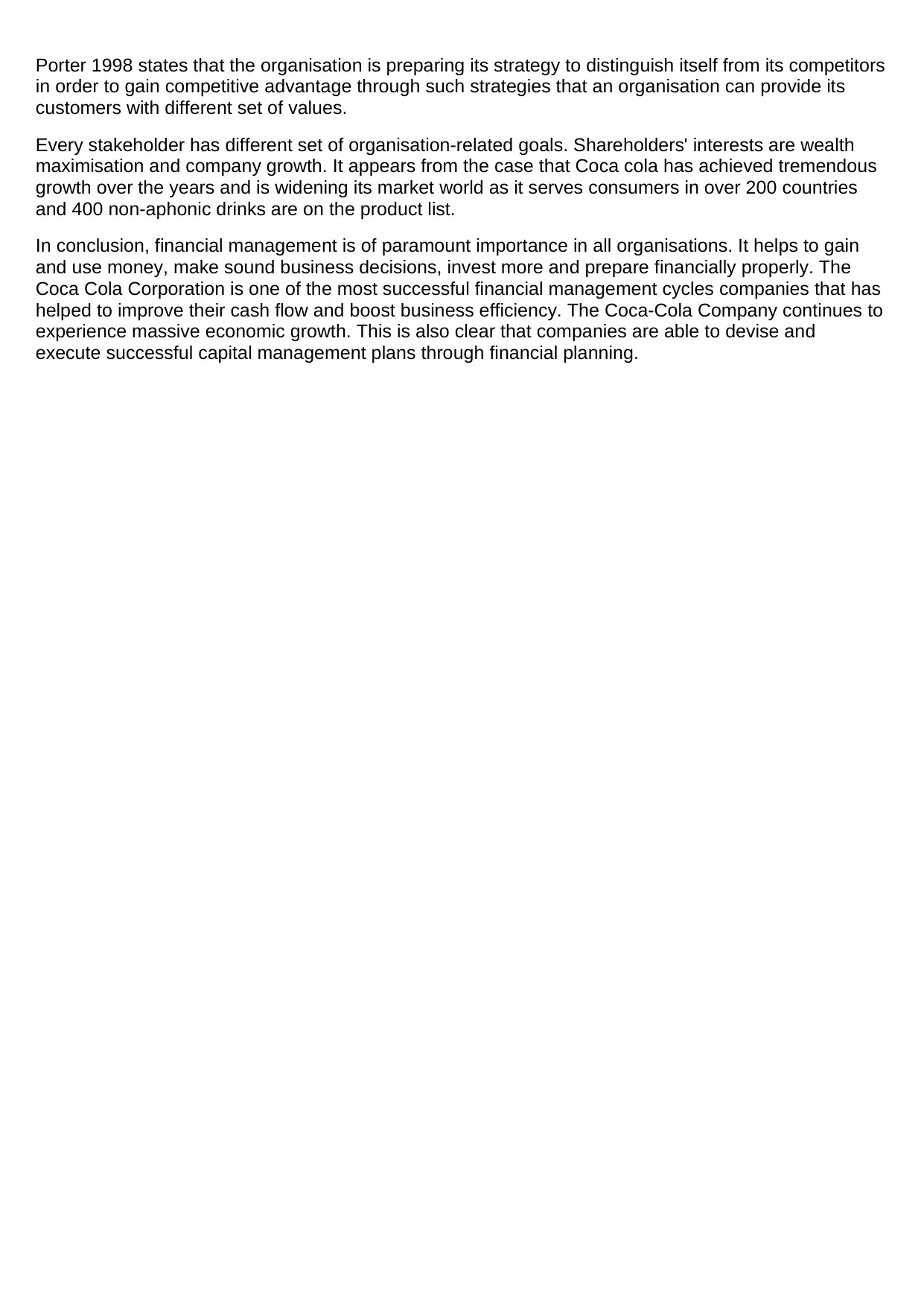
Porter 1998 states that the organisation is preparing its strategy to distinguish itself from its competitors
in order to gain competitive advantage through such strategies that an organisation can provide its
customers with different set of values.
Every stakeholder has different set of organisation-related goals. Shareholders' interests are wealth
maximisation and company growth. It appears from the case that Coca cola has achieved tremendous
growth over the years and is widening its market world as it serves consumers in over 200 countries
and 400 non-aphonic drinks are on the product list.
In conclusion, financial management is of paramount importance in all organisations. It helps to gain
and use money, make sound business decisions, invest more and prepare financially properly. The
Coca Cola Corporation is one of the most successful financial management cycles companies that has
helped to improve their cash flow and boost business efficiency. The Coca-Cola Company continues to
experience massive economic growth. This is also clear that companies are able to devise and
execute successful capital management plans through financial planning.
in order to gain competitive advantage through such strategies that an organisation can provide its
customers with different set of values.
Every stakeholder has different set of organisation-related goals. Shareholders' interests are wealth
maximisation and company growth. It appears from the case that Coca cola has achieved tremendous
growth over the years and is widening its market world as it serves consumers in over 200 countries
and 400 non-aphonic drinks are on the product list.
In conclusion, financial management is of paramount importance in all organisations. It helps to gain
and use money, make sound business decisions, invest more and prepare financially properly. The
Coca Cola Corporation is one of the most successful financial management cycles companies that has
helped to improve their cash flow and boost business efficiency. The Coca-Cola Company continues to
experience massive economic growth. This is also clear that companies are able to devise and
execute successful capital management plans through financial planning.
⊘ This is a preview!⊘
Do you want full access?
Subscribe today to unlock all pages.

Trusted by 1+ million students worldwide
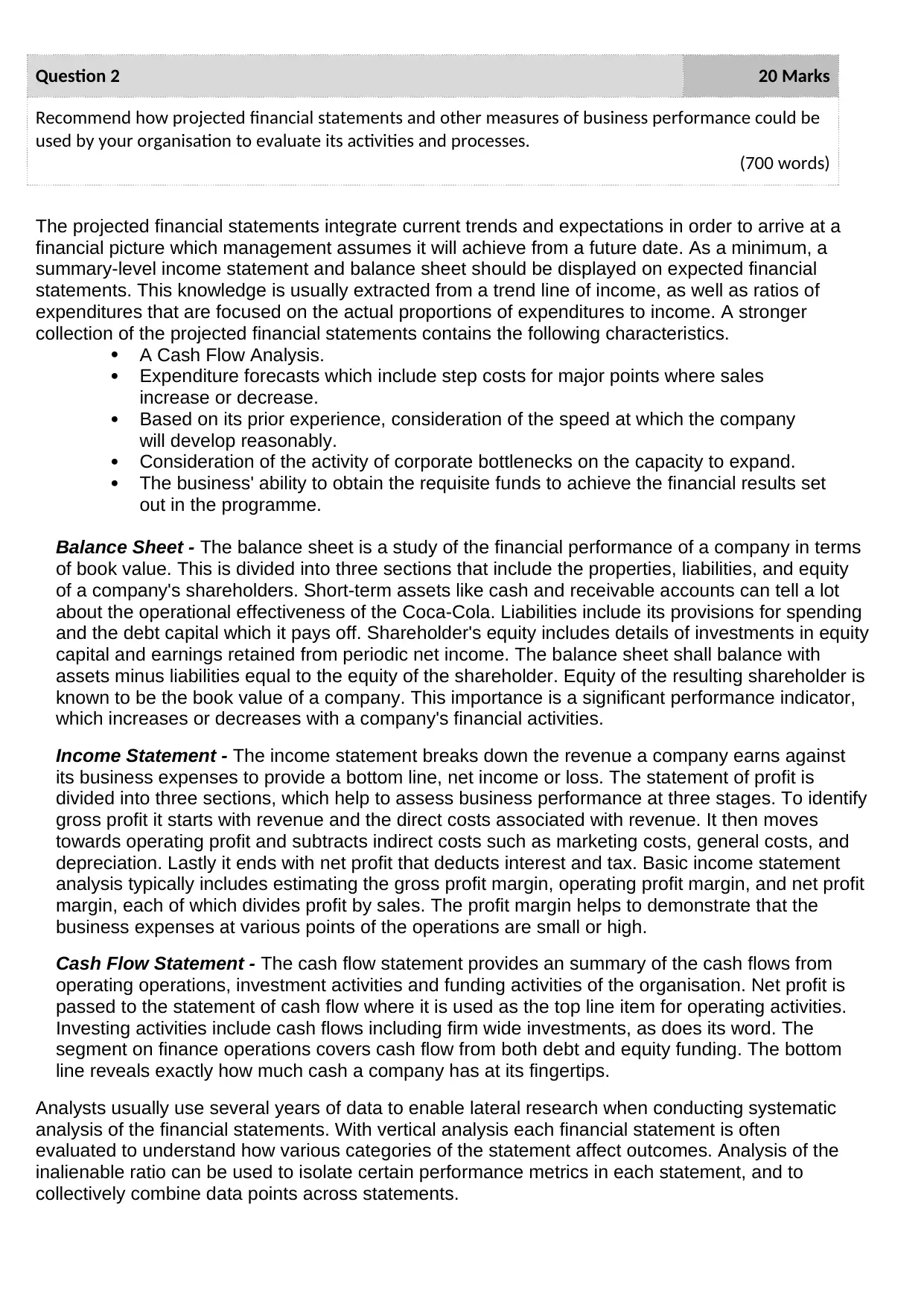
Question 2 20 Marks
Recommend how projected financial statements and other measures of business performance could be
used by your organisation to evaluate its activities and processes.
(700 words)
The projected financial statements integrate current trends and expectations in order to arrive at a
financial picture which management assumes it will achieve from a future date. As a minimum, a
summary-level income statement and balance sheet should be displayed on expected financial
statements. This knowledge is usually extracted from a trend line of income, as well as ratios of
expenditures that are focused on the actual proportions of expenditures to income. A stronger
collection of the projected financial statements contains the following characteristics.
A Cash Flow Analysis.
Expenditure forecasts which include step costs for major points where sales
increase or decrease.
Based on its prior experience, consideration of the speed at which the company
will develop reasonably.
Consideration of the activity of corporate bottlenecks on the capacity to expand.
The business' ability to obtain the requisite funds to achieve the financial results set
out in the programme.
Balance Sheet - The balance sheet is a study of the financial performance of a company in terms
of book value. This is divided into three sections that include the properties, liabilities, and equity
of a company's shareholders. Short-term assets like cash and receivable accounts can tell a lot
about the operational effectiveness of the Coca-Cola. Liabilities include its provisions for spending
and the debt capital which it pays off. Shareholder's equity includes details of investments in equity
capital and earnings retained from periodic net income. The balance sheet shall balance with
assets minus liabilities equal to the equity of the shareholder. Equity of the resulting shareholder is
known to be the book value of a company. This importance is a significant performance indicator,
which increases or decreases with a company's financial activities.
Income Statement - The income statement breaks down the revenue a company earns against
its business expenses to provide a bottom line, net income or loss. The statement of profit is
divided into three sections, which help to assess business performance at three stages. To identify
gross profit it starts with revenue and the direct costs associated with revenue. It then moves
towards operating profit and subtracts indirect costs such as marketing costs, general costs, and
depreciation. Lastly it ends with net profit that deducts interest and tax. Basic income statement
analysis typically includes estimating the gross profit margin, operating profit margin, and net profit
margin, each of which divides profit by sales. The profit margin helps to demonstrate that the
business expenses at various points of the operations are small or high.
Cash Flow Statement - The cash flow statement provides an summary of the cash flows from
operating operations, investment activities and funding activities of the organisation. Net profit is
passed to the statement of cash flow where it is used as the top line item for operating activities.
Investing activities include cash flows including firm wide investments, as does its word. The
segment on finance operations covers cash flow from both debt and equity funding. The bottom
line reveals exactly how much cash a company has at its fingertips.
Analysts usually use several years of data to enable lateral research when conducting systematic
analysis of the financial statements. With vertical analysis each financial statement is often
evaluated to understand how various categories of the statement affect outcomes. Analysis of the
inalienable ratio can be used to isolate certain performance metrics in each statement, and to
collectively combine data points across statements.
Recommend how projected financial statements and other measures of business performance could be
used by your organisation to evaluate its activities and processes.
(700 words)
The projected financial statements integrate current trends and expectations in order to arrive at a
financial picture which management assumes it will achieve from a future date. As a minimum, a
summary-level income statement and balance sheet should be displayed on expected financial
statements. This knowledge is usually extracted from a trend line of income, as well as ratios of
expenditures that are focused on the actual proportions of expenditures to income. A stronger
collection of the projected financial statements contains the following characteristics.
A Cash Flow Analysis.
Expenditure forecasts which include step costs for major points where sales
increase or decrease.
Based on its prior experience, consideration of the speed at which the company
will develop reasonably.
Consideration of the activity of corporate bottlenecks on the capacity to expand.
The business' ability to obtain the requisite funds to achieve the financial results set
out in the programme.
Balance Sheet - The balance sheet is a study of the financial performance of a company in terms
of book value. This is divided into three sections that include the properties, liabilities, and equity
of a company's shareholders. Short-term assets like cash and receivable accounts can tell a lot
about the operational effectiveness of the Coca-Cola. Liabilities include its provisions for spending
and the debt capital which it pays off. Shareholder's equity includes details of investments in equity
capital and earnings retained from periodic net income. The balance sheet shall balance with
assets minus liabilities equal to the equity of the shareholder. Equity of the resulting shareholder is
known to be the book value of a company. This importance is a significant performance indicator,
which increases or decreases with a company's financial activities.
Income Statement - The income statement breaks down the revenue a company earns against
its business expenses to provide a bottom line, net income or loss. The statement of profit is
divided into three sections, which help to assess business performance at three stages. To identify
gross profit it starts with revenue and the direct costs associated with revenue. It then moves
towards operating profit and subtracts indirect costs such as marketing costs, general costs, and
depreciation. Lastly it ends with net profit that deducts interest and tax. Basic income statement
analysis typically includes estimating the gross profit margin, operating profit margin, and net profit
margin, each of which divides profit by sales. The profit margin helps to demonstrate that the
business expenses at various points of the operations are small or high.
Cash Flow Statement - The cash flow statement provides an summary of the cash flows from
operating operations, investment activities and funding activities of the organisation. Net profit is
passed to the statement of cash flow where it is used as the top line item for operating activities.
Investing activities include cash flows including firm wide investments, as does its word. The
segment on finance operations covers cash flow from both debt and equity funding. The bottom
line reveals exactly how much cash a company has at its fingertips.
Analysts usually use several years of data to enable lateral research when conducting systematic
analysis of the financial statements. With vertical analysis each financial statement is often
evaluated to understand how various categories of the statement affect outcomes. Analysis of the
inalienable ratio can be used to isolate certain performance metrics in each statement, and to
collectively combine data points across statements.
Paraphrase This Document
Need a fresh take? Get an instant paraphrase of this document with our AI Paraphraser
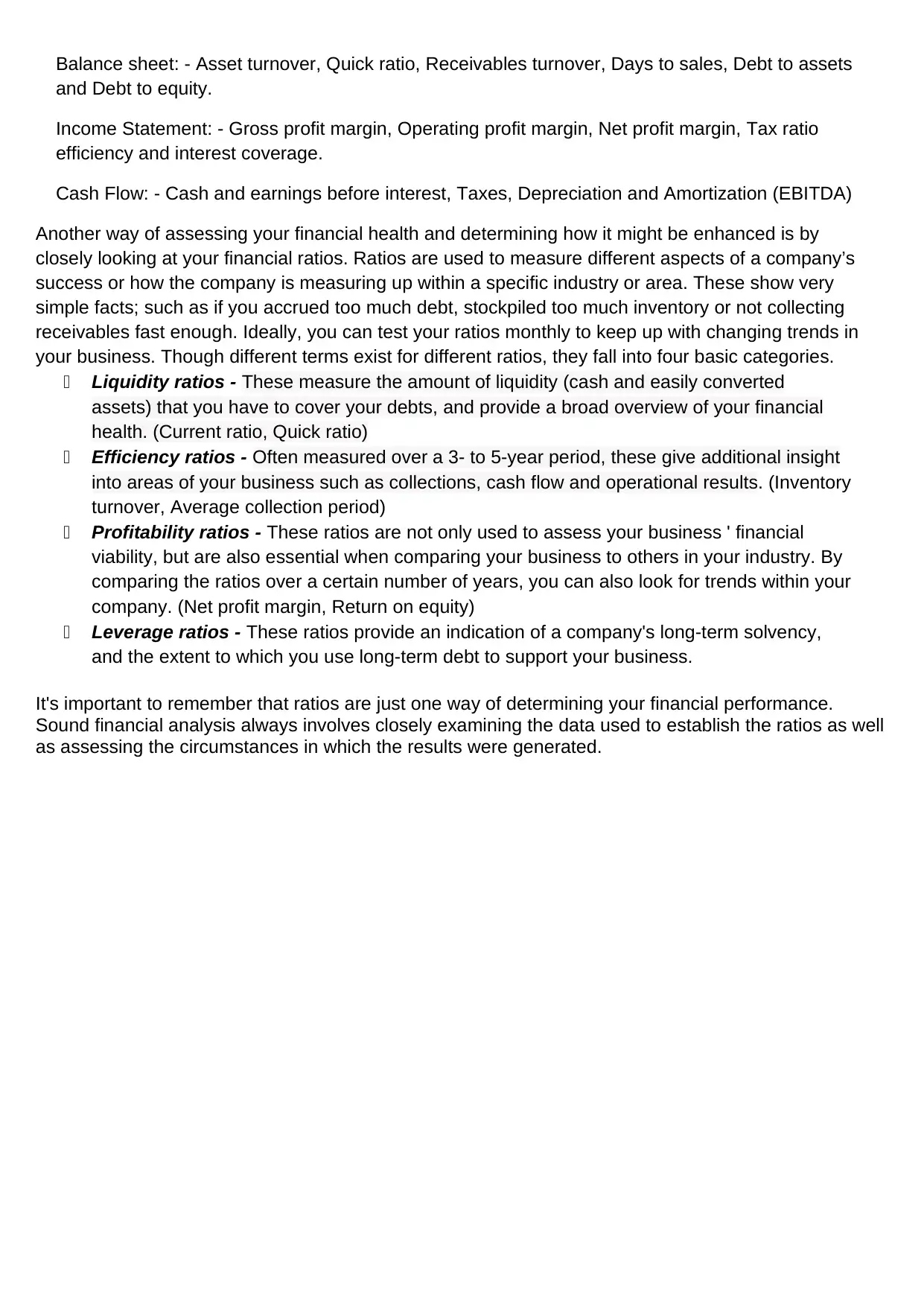
Balance sheet: - Asset turnover, Quick ratio, Receivables turnover, Days to sales, Debt to assets
and Debt to equity.
Income Statement: - Gross profit margin, Operating profit margin, Net profit margin, Tax ratio
efficiency and interest coverage.
Cash Flow: - Cash and earnings before interest, Taxes, Depreciation and Amortization (EBITDA)
Another way of assessing your financial health and determining how it might be enhanced is by
closely looking at your financial ratios. Ratios are used to measure different aspects of a company’s
success or how the company is measuring up within a specific industry or area. These show very
simple facts; such as if you accrued too much debt, stockpiled too much inventory or not collecting
receivables fast enough. Ideally, you can test your ratios monthly to keep up with changing trends in
your business. Though different terms exist for different ratios, they fall into four basic categories.
Liquidity ratios - These measure the amount of liquidity (cash and easily converted
assets) that you have to cover your debts, and provide a broad overview of your financial
health. (Current ratio, Quick ratio)
Efficiency ratios - Often measured over a 3- to 5-year period, these give additional insight
into areas of your business such as collections, cash flow and operational results. (Inventory
turnover, Average collection period)
Profitability ratios - These ratios are not only used to assess your business ' financial
viability, but are also essential when comparing your business to others in your industry. By
comparing the ratios over a certain number of years, you can also look for trends within your
company. (Net profit margin, Return on equity)
Leverage ratios - These ratios provide an indication of a company's long-term solvency,
and the extent to which you use long-term debt to support your business.
It's important to remember that ratios are just one way of determining your financial performance.
Sound financial analysis always involves closely examining the data used to establish the ratios as well
as assessing the circumstances in which the results were generated.
and Debt to equity.
Income Statement: - Gross profit margin, Operating profit margin, Net profit margin, Tax ratio
efficiency and interest coverage.
Cash Flow: - Cash and earnings before interest, Taxes, Depreciation and Amortization (EBITDA)
Another way of assessing your financial health and determining how it might be enhanced is by
closely looking at your financial ratios. Ratios are used to measure different aspects of a company’s
success or how the company is measuring up within a specific industry or area. These show very
simple facts; such as if you accrued too much debt, stockpiled too much inventory or not collecting
receivables fast enough. Ideally, you can test your ratios monthly to keep up with changing trends in
your business. Though different terms exist for different ratios, they fall into four basic categories.
Liquidity ratios - These measure the amount of liquidity (cash and easily converted
assets) that you have to cover your debts, and provide a broad overview of your financial
health. (Current ratio, Quick ratio)
Efficiency ratios - Often measured over a 3- to 5-year period, these give additional insight
into areas of your business such as collections, cash flow and operational results. (Inventory
turnover, Average collection period)
Profitability ratios - These ratios are not only used to assess your business ' financial
viability, but are also essential when comparing your business to others in your industry. By
comparing the ratios over a certain number of years, you can also look for trends within your
company. (Net profit margin, Return on equity)
Leverage ratios - These ratios provide an indication of a company's long-term solvency,
and the extent to which you use long-term debt to support your business.
It's important to remember that ratios are just one way of determining your financial performance.
Sound financial analysis always involves closely examining the data used to establish the ratios as well
as assessing the circumstances in which the results were generated.
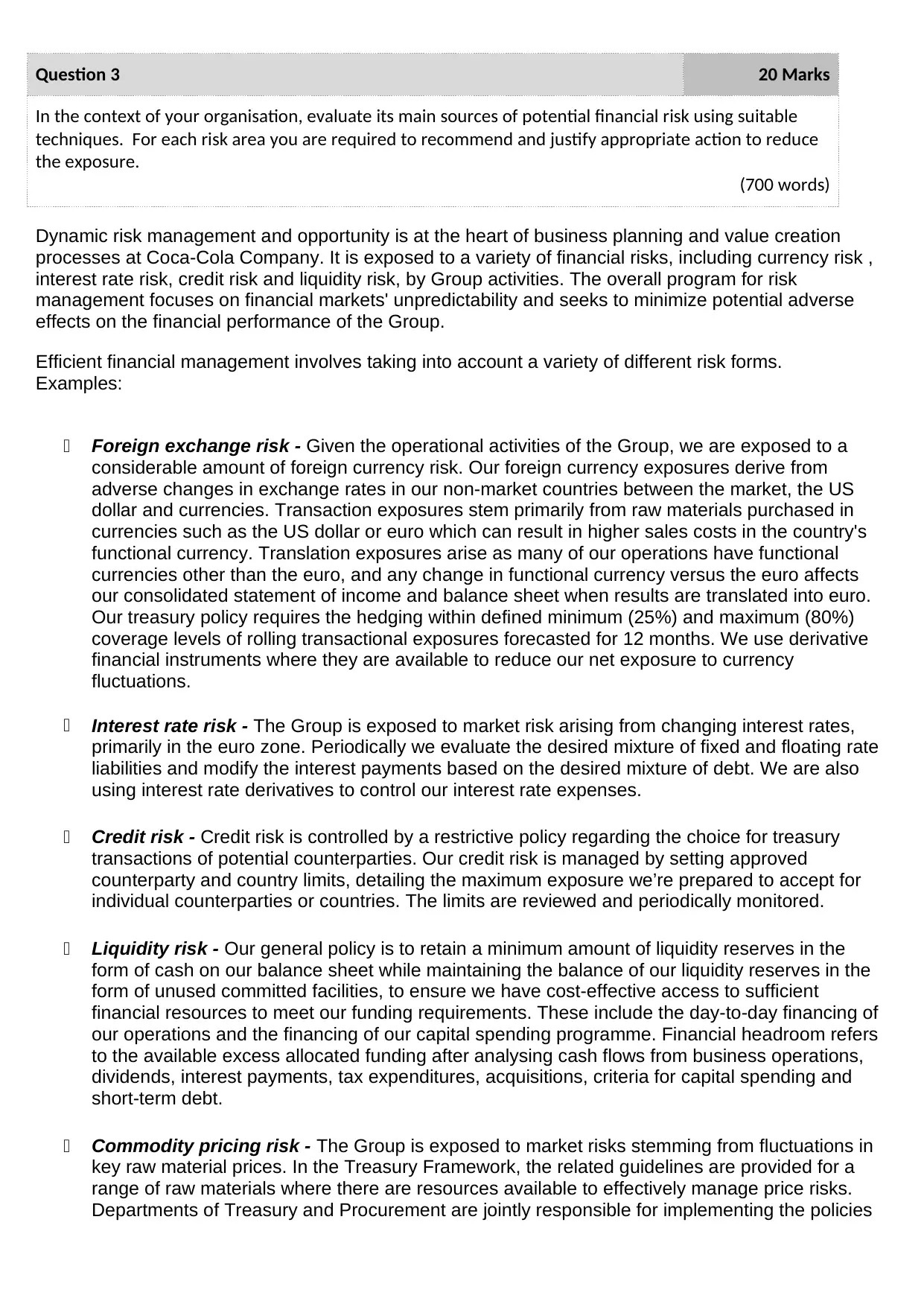
Question 3 20 Marks
In the context of your organisation, evaluate its main sources of potential financial risk using suitable
techniques. For each risk area you are required to recommend and justify appropriate action to reduce
the exposure.
(700 words)
Dynamic risk management and opportunity is at the heart of business planning and value creation
processes at Coca-Cola Company. It is exposed to a variety of financial risks, including currency risk ,
interest rate risk, credit risk and liquidity risk, by Group activities. The overall program for risk
management focuses on financial markets' unpredictability and seeks to minimize potential adverse
effects on the financial performance of the Group.
Efficient financial management involves taking into account a variety of different risk forms.
Examples:
Foreign exchange risk - Given the operational activities of the Group, we are exposed to a
considerable amount of foreign currency risk. Our foreign currency exposures derive from
adverse changes in exchange rates in our non-market countries between the market, the US
dollar and currencies. Transaction exposures stem primarily from raw materials purchased in
currencies such as the US dollar or euro which can result in higher sales costs in the country's
functional currency. Translation exposures arise as many of our operations have functional
currencies other than the euro, and any change in functional currency versus the euro affects
our consolidated statement of income and balance sheet when results are translated into euro.
Our treasury policy requires the hedging within defined minimum (25%) and maximum (80%)
coverage levels of rolling transactional exposures forecasted for 12 months. We use derivative
financial instruments where they are available to reduce our net exposure to currency
fluctuations.
Interest rate risk - The Group is exposed to market risk arising from changing interest rates,
primarily in the euro zone. Periodically we evaluate the desired mixture of fixed and floating rate
liabilities and modify the interest payments based on the desired mixture of debt. We are also
using interest rate derivatives to control our interest rate expenses.
Credit risk - Credit risk is controlled by a restrictive policy regarding the choice for treasury
transactions of potential counterparties. Our credit risk is managed by setting approved
counterparty and country limits, detailing the maximum exposure we’re prepared to accept for
individual counterparties or countries. The limits are reviewed and periodically monitored.
Liquidity risk - Our general policy is to retain a minimum amount of liquidity reserves in the
form of cash on our balance sheet while maintaining the balance of our liquidity reserves in the
form of unused committed facilities, to ensure we have cost-effective access to sufficient
financial resources to meet our funding requirements. These include the day-to-day financing of
our operations and the financing of our capital spending programme. Financial headroom refers
to the available excess allocated funding after analysing cash flows from business operations,
dividends, interest payments, tax expenditures, acquisitions, criteria for capital spending and
short-term debt.
Commodity pricing risk - The Group is exposed to market risks stemming from fluctuations in
key raw material prices. In the Treasury Framework, the related guidelines are provided for a
range of raw materials where there are resources available to effectively manage price risks.
Departments of Treasury and Procurement are jointly responsible for implementing the policies
In the context of your organisation, evaluate its main sources of potential financial risk using suitable
techniques. For each risk area you are required to recommend and justify appropriate action to reduce
the exposure.
(700 words)
Dynamic risk management and opportunity is at the heart of business planning and value creation
processes at Coca-Cola Company. It is exposed to a variety of financial risks, including currency risk ,
interest rate risk, credit risk and liquidity risk, by Group activities. The overall program for risk
management focuses on financial markets' unpredictability and seeks to minimize potential adverse
effects on the financial performance of the Group.
Efficient financial management involves taking into account a variety of different risk forms.
Examples:
Foreign exchange risk - Given the operational activities of the Group, we are exposed to a
considerable amount of foreign currency risk. Our foreign currency exposures derive from
adverse changes in exchange rates in our non-market countries between the market, the US
dollar and currencies. Transaction exposures stem primarily from raw materials purchased in
currencies such as the US dollar or euro which can result in higher sales costs in the country's
functional currency. Translation exposures arise as many of our operations have functional
currencies other than the euro, and any change in functional currency versus the euro affects
our consolidated statement of income and balance sheet when results are translated into euro.
Our treasury policy requires the hedging within defined minimum (25%) and maximum (80%)
coverage levels of rolling transactional exposures forecasted for 12 months. We use derivative
financial instruments where they are available to reduce our net exposure to currency
fluctuations.
Interest rate risk - The Group is exposed to market risk arising from changing interest rates,
primarily in the euro zone. Periodically we evaluate the desired mixture of fixed and floating rate
liabilities and modify the interest payments based on the desired mixture of debt. We are also
using interest rate derivatives to control our interest rate expenses.
Credit risk - Credit risk is controlled by a restrictive policy regarding the choice for treasury
transactions of potential counterparties. Our credit risk is managed by setting approved
counterparty and country limits, detailing the maximum exposure we’re prepared to accept for
individual counterparties or countries. The limits are reviewed and periodically monitored.
Liquidity risk - Our general policy is to retain a minimum amount of liquidity reserves in the
form of cash on our balance sheet while maintaining the balance of our liquidity reserves in the
form of unused committed facilities, to ensure we have cost-effective access to sufficient
financial resources to meet our funding requirements. These include the day-to-day financing of
our operations and the financing of our capital spending programme. Financial headroom refers
to the available excess allocated funding after analysing cash flows from business operations,
dividends, interest payments, tax expenditures, acquisitions, criteria for capital spending and
short-term debt.
Commodity pricing risk - The Group is exposed to market risks stemming from fluctuations in
key raw material prices. In the Treasury Framework, the related guidelines are provided for a
range of raw materials where there are resources available to effectively manage price risks.
Departments of Treasury and Procurement are jointly responsible for implementing the policies
⊘ This is a preview!⊘
Do you want full access?
Subscribe today to unlock all pages.

Trusted by 1+ million students worldwide
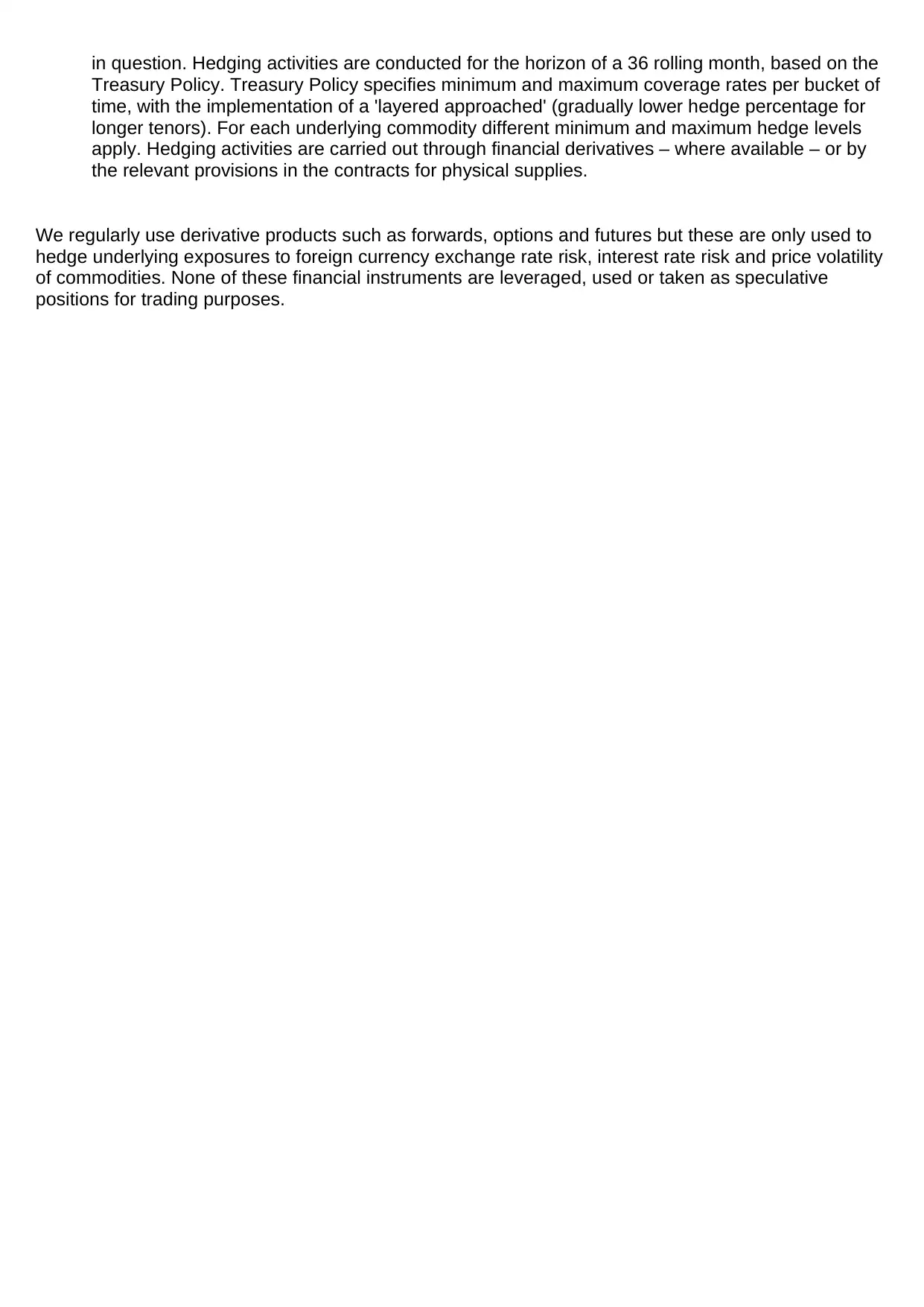
in question. Hedging activities are conducted for the horizon of a 36 rolling month, based on the
Treasury Policy. Treasury Policy specifies minimum and maximum coverage rates per bucket of
time, with the implementation of a 'layered approached' (gradually lower hedge percentage for
longer tenors). For each underlying commodity different minimum and maximum hedge levels
apply. Hedging activities are carried out through financial derivatives – where available – or by
the relevant provisions in the contracts for physical supplies.
We regularly use derivative products such as forwards, options and futures but these are only used to
hedge underlying exposures to foreign currency exchange rate risk, interest rate risk and price volatility
of commodities. None of these financial instruments are leveraged, used or taken as speculative
positions for trading purposes.
Treasury Policy. Treasury Policy specifies minimum and maximum coverage rates per bucket of
time, with the implementation of a 'layered approached' (gradually lower hedge percentage for
longer tenors). For each underlying commodity different minimum and maximum hedge levels
apply. Hedging activities are carried out through financial derivatives – where available – or by
the relevant provisions in the contracts for physical supplies.
We regularly use derivative products such as forwards, options and futures but these are only used to
hedge underlying exposures to foreign currency exchange rate risk, interest rate risk and price volatility
of commodities. None of these financial instruments are leveraged, used or taken as speculative
positions for trading purposes.
Paraphrase This Document
Need a fresh take? Get an instant paraphrase of this document with our AI Paraphraser
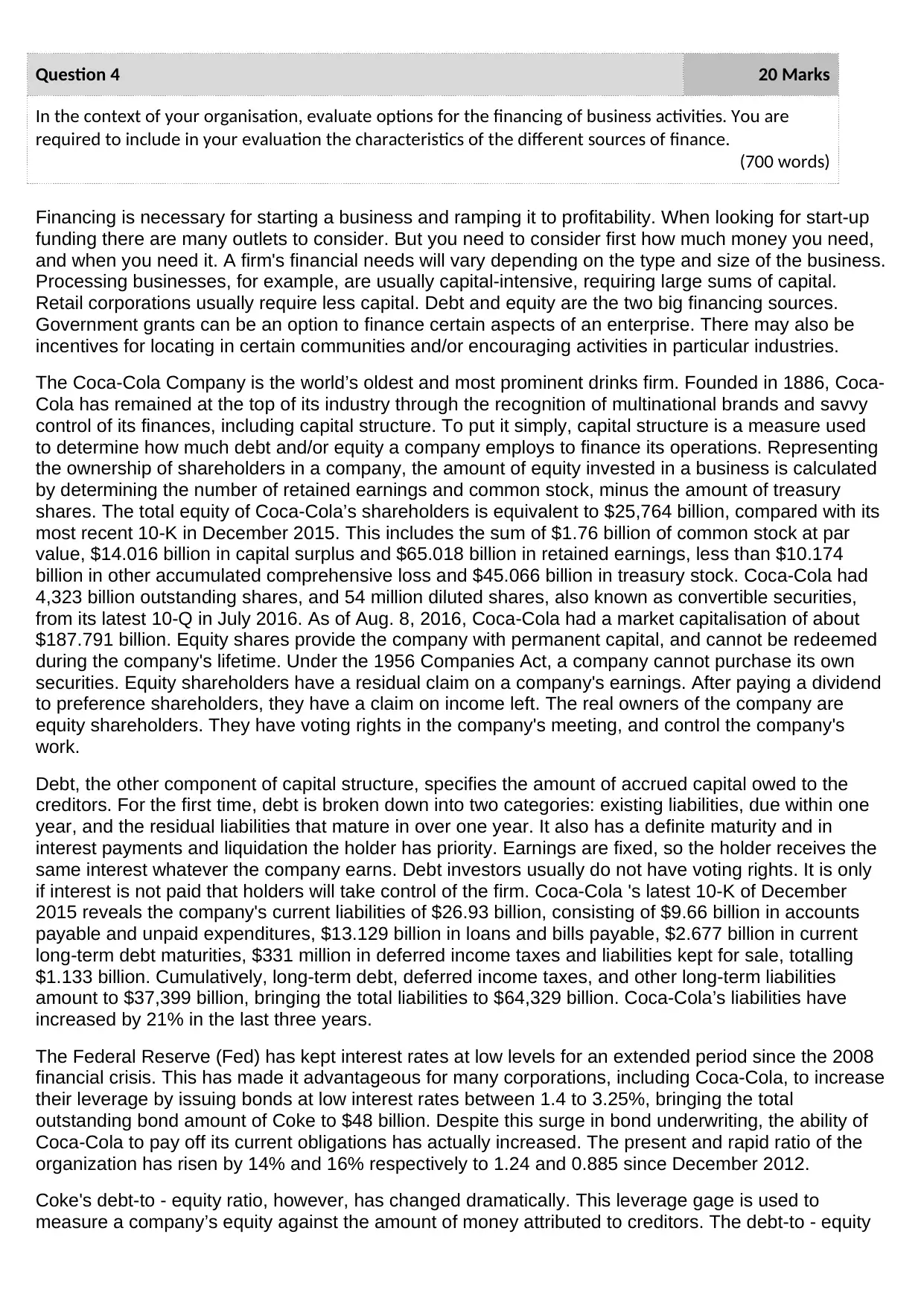
Question 4 20 Marks
In the context of your organisation, evaluate options for the financing of business activities. You are
required to include in your evaluation the characteristics of the different sources of finance.
(700 words)
Financing is necessary for starting a business and ramping it to profitability. When looking for start-up
funding there are many outlets to consider. But you need to consider first how much money you need,
and when you need it. A firm's financial needs will vary depending on the type and size of the business.
Processing businesses, for example, are usually capital-intensive, requiring large sums of capital.
Retail corporations usually require less capital. Debt and equity are the two big financing sources.
Government grants can be an option to finance certain aspects of an enterprise. There may also be
incentives for locating in certain communities and/or encouraging activities in particular industries.
The Coca-Cola Company is the world’s oldest and most prominent drinks firm. Founded in 1886, Coca-
Cola has remained at the top of its industry through the recognition of multinational brands and savvy
control of its finances, including capital structure. To put it simply, capital structure is a measure used
to determine how much debt and/or equity a company employs to finance its operations. Representing
the ownership of shareholders in a company, the amount of equity invested in a business is calculated
by determining the number of retained earnings and common stock, minus the amount of treasury
shares. The total equity of Coca-Cola’s shareholders is equivalent to $25,764 billion, compared with its
most recent 10-K in December 2015. This includes the sum of $1.76 billion of common stock at par
value, $14.016 billion in capital surplus and $65.018 billion in retained earnings, less than $10.174
billion in other accumulated comprehensive loss and $45.066 billion in treasury stock. Coca-Cola had
4,323 billion outstanding shares, and 54 million diluted shares, also known as convertible securities,
from its latest 10-Q in July 2016. As of Aug. 8, 2016, Coca-Cola had a market capitalisation of about
$187.791 billion. Equity shares provide the company with permanent capital, and cannot be redeemed
during the company's lifetime. Under the 1956 Companies Act, a company cannot purchase its own
securities. Equity shareholders have a residual claim on a company's earnings. After paying a dividend
to preference shareholders, they have a claim on income left. The real owners of the company are
equity shareholders. They have voting rights in the company's meeting, and control the company's
work.
Debt, the other component of capital structure, specifies the amount of accrued capital owed to the
creditors. For the first time, debt is broken down into two categories: existing liabilities, due within one
year, and the residual liabilities that mature in over one year. It also has a definite maturity and in
interest payments and liquidation the holder has priority. Earnings are fixed, so the holder receives the
same interest whatever the company earns. Debt investors usually do not have voting rights. It is only
if interest is not paid that holders will take control of the firm. Coca-Cola 's latest 10-K of December
2015 reveals the company's current liabilities of $26.93 billion, consisting of $9.66 billion in accounts
payable and unpaid expenditures, $13.129 billion in loans and bills payable, $2.677 billion in current
long-term debt maturities, $331 million in deferred income taxes and liabilities kept for sale, totalling
$1.133 billion. Cumulatively, long-term debt, deferred income taxes, and other long-term liabilities
amount to $37,399 billion, bringing the total liabilities to $64,329 billion. Coca-Cola’s liabilities have
increased by 21% in the last three years.
The Federal Reserve (Fed) has kept interest rates at low levels for an extended period since the 2008
financial crisis. This has made it advantageous for many corporations, including Coca-Cola, to increase
their leverage by issuing bonds at low interest rates between 1.4 to 3.25%, bringing the total
outstanding bond amount of Coke to $48 billion. Despite this surge in bond underwriting, the ability of
Coca-Cola to pay off its current obligations has actually increased. The present and rapid ratio of the
organization has risen by 14% and 16% respectively to 1.24 and 0.885 since December 2012.
Coke's debt-to - equity ratio, however, has changed dramatically. This leverage gage is used to
measure a company’s equity against the amount of money attributed to creditors. The debt-to - equity
In the context of your organisation, evaluate options for the financing of business activities. You are
required to include in your evaluation the characteristics of the different sources of finance.
(700 words)
Financing is necessary for starting a business and ramping it to profitability. When looking for start-up
funding there are many outlets to consider. But you need to consider first how much money you need,
and when you need it. A firm's financial needs will vary depending on the type and size of the business.
Processing businesses, for example, are usually capital-intensive, requiring large sums of capital.
Retail corporations usually require less capital. Debt and equity are the two big financing sources.
Government grants can be an option to finance certain aspects of an enterprise. There may also be
incentives for locating in certain communities and/or encouraging activities in particular industries.
The Coca-Cola Company is the world’s oldest and most prominent drinks firm. Founded in 1886, Coca-
Cola has remained at the top of its industry through the recognition of multinational brands and savvy
control of its finances, including capital structure. To put it simply, capital structure is a measure used
to determine how much debt and/or equity a company employs to finance its operations. Representing
the ownership of shareholders in a company, the amount of equity invested in a business is calculated
by determining the number of retained earnings and common stock, minus the amount of treasury
shares. The total equity of Coca-Cola’s shareholders is equivalent to $25,764 billion, compared with its
most recent 10-K in December 2015. This includes the sum of $1.76 billion of common stock at par
value, $14.016 billion in capital surplus and $65.018 billion in retained earnings, less than $10.174
billion in other accumulated comprehensive loss and $45.066 billion in treasury stock. Coca-Cola had
4,323 billion outstanding shares, and 54 million diluted shares, also known as convertible securities,
from its latest 10-Q in July 2016. As of Aug. 8, 2016, Coca-Cola had a market capitalisation of about
$187.791 billion. Equity shares provide the company with permanent capital, and cannot be redeemed
during the company's lifetime. Under the 1956 Companies Act, a company cannot purchase its own
securities. Equity shareholders have a residual claim on a company's earnings. After paying a dividend
to preference shareholders, they have a claim on income left. The real owners of the company are
equity shareholders. They have voting rights in the company's meeting, and control the company's
work.
Debt, the other component of capital structure, specifies the amount of accrued capital owed to the
creditors. For the first time, debt is broken down into two categories: existing liabilities, due within one
year, and the residual liabilities that mature in over one year. It also has a definite maturity and in
interest payments and liquidation the holder has priority. Earnings are fixed, so the holder receives the
same interest whatever the company earns. Debt investors usually do not have voting rights. It is only
if interest is not paid that holders will take control of the firm. Coca-Cola 's latest 10-K of December
2015 reveals the company's current liabilities of $26.93 billion, consisting of $9.66 billion in accounts
payable and unpaid expenditures, $13.129 billion in loans and bills payable, $2.677 billion in current
long-term debt maturities, $331 million in deferred income taxes and liabilities kept for sale, totalling
$1.133 billion. Cumulatively, long-term debt, deferred income taxes, and other long-term liabilities
amount to $37,399 billion, bringing the total liabilities to $64,329 billion. Coca-Cola’s liabilities have
increased by 21% in the last three years.
The Federal Reserve (Fed) has kept interest rates at low levels for an extended period since the 2008
financial crisis. This has made it advantageous for many corporations, including Coca-Cola, to increase
their leverage by issuing bonds at low interest rates between 1.4 to 3.25%, bringing the total
outstanding bond amount of Coke to $48 billion. Despite this surge in bond underwriting, the ability of
Coca-Cola to pay off its current obligations has actually increased. The present and rapid ratio of the
organization has risen by 14% and 16% respectively to 1.24 and 0.885 since December 2012.
Coke's debt-to - equity ratio, however, has changed dramatically. This leverage gage is used to
measure a company’s equity against the amount of money attributed to creditors. The debt-to - equity
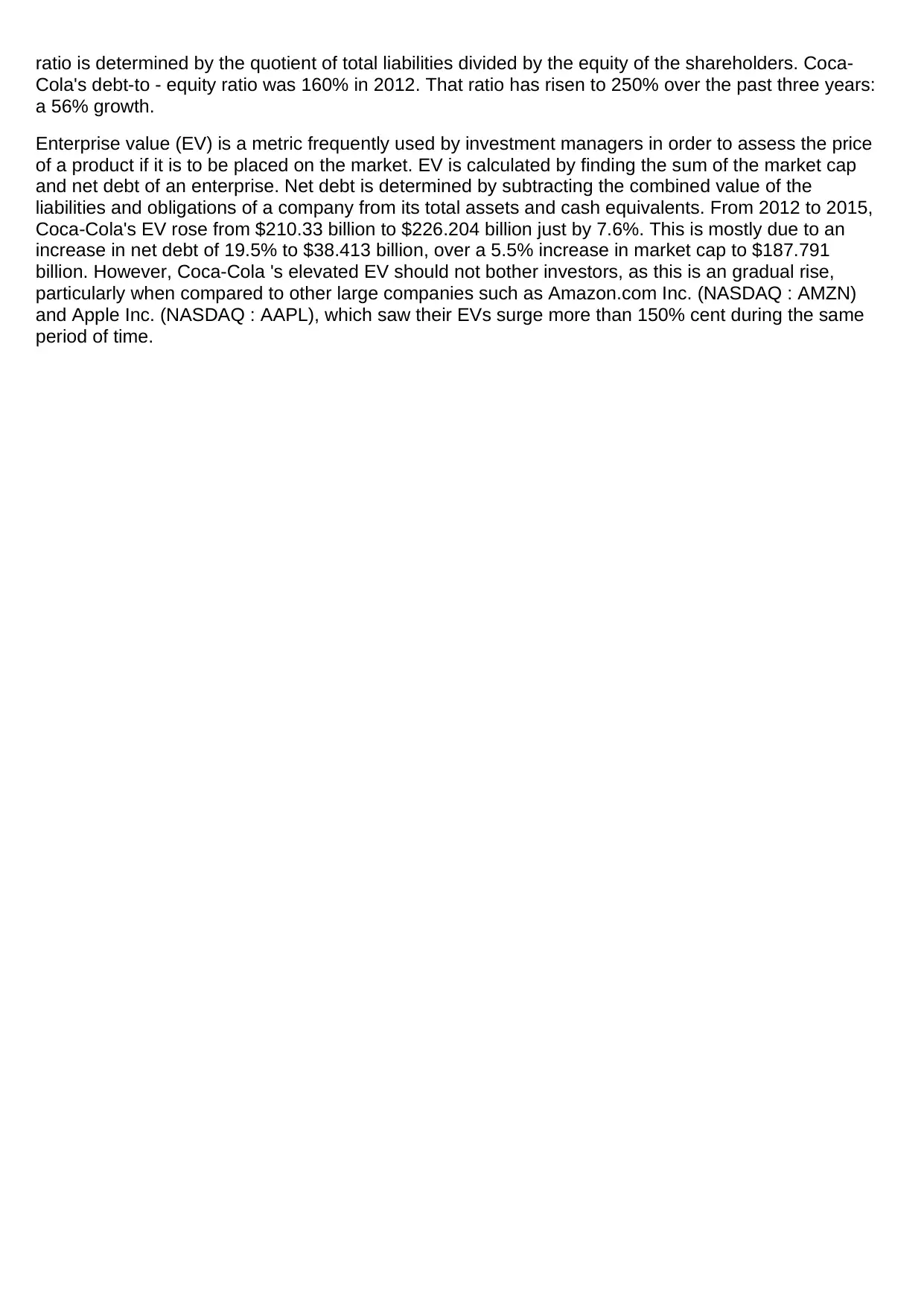
ratio is determined by the quotient of total liabilities divided by the equity of the shareholders. Coca-
Cola's debt-to - equity ratio was 160% in 2012. That ratio has risen to 250% over the past three years:
a 56% growth.
Enterprise value (EV) is a metric frequently used by investment managers in order to assess the price
of a product if it is to be placed on the market. EV is calculated by finding the sum of the market cap
and net debt of an enterprise. Net debt is determined by subtracting the combined value of the
liabilities and obligations of a company from its total assets and cash equivalents. From 2012 to 2015,
Coca-Cola's EV rose from $210.33 billion to $226.204 billion just by 7.6%. This is mostly due to an
increase in net debt of 19.5% to $38.413 billion, over a 5.5% increase in market cap to $187.791
billion. However, Coca-Cola 's elevated EV should not bother investors, as this is an gradual rise,
particularly when compared to other large companies such as Amazon.com Inc. (NASDAQ : AMZN)
and Apple Inc. (NASDAQ : AAPL), which saw their EVs surge more than 150% cent during the same
period of time.
Cola's debt-to - equity ratio was 160% in 2012. That ratio has risen to 250% over the past three years:
a 56% growth.
Enterprise value (EV) is a metric frequently used by investment managers in order to assess the price
of a product if it is to be placed on the market. EV is calculated by finding the sum of the market cap
and net debt of an enterprise. Net debt is determined by subtracting the combined value of the
liabilities and obligations of a company from its total assets and cash equivalents. From 2012 to 2015,
Coca-Cola's EV rose from $210.33 billion to $226.204 billion just by 7.6%. This is mostly due to an
increase in net debt of 19.5% to $38.413 billion, over a 5.5% increase in market cap to $187.791
billion. However, Coca-Cola 's elevated EV should not bother investors, as this is an gradual rise,
particularly when compared to other large companies such as Amazon.com Inc. (NASDAQ : AMZN)
and Apple Inc. (NASDAQ : AAPL), which saw their EVs surge more than 150% cent during the same
period of time.
⊘ This is a preview!⊘
Do you want full access?
Subscribe today to unlock all pages.

Trusted by 1+ million students worldwide
1 out of 22
Related Documents
Your All-in-One AI-Powered Toolkit for Academic Success.
+13062052269
info@desklib.com
Available 24*7 on WhatsApp / Email
![[object Object]](/_next/static/media/star-bottom.7253800d.svg)
Unlock your academic potential
Copyright © 2020–2025 A2Z Services. All Rights Reserved. Developed and managed by ZUCOL.





